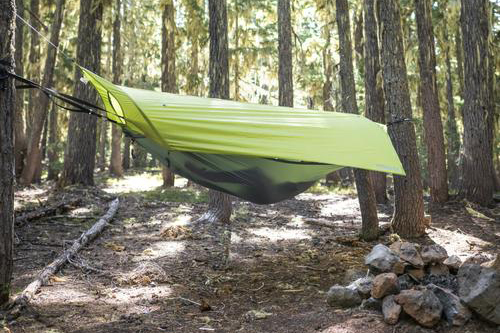
When it comes to the outdoors, a few nights on the lumpy ground can ruin the outlook of any hiker. Forget the mountains and fresh air; all you’ll want is your bedroom’s foam matures. That’s why, when it comes to solo overnight adventures, we recommend switching out your old tent and moving your campsite up into the trees. Hammocks have been used by hikers for years because of their light weight, adaptability, and lack of tent poles. If you’ve been hammock-curious, now’s the time to take the plunge with the Klymit Sky Bivy.
Some people, thinking back to their boozy vacations in Puerto Vallarta cabanas, might question the long-term efficiency of sleeping in a hammock. “Won’t its collapsing sides roll your shoulders into the shape of a burrito, effectively smothering you as you try to sleep?” they ask. For this reason, hammocks like the Sky Bivy feature spreader bars on each end, which ensure a relatively flat surface upon which to sleep. No more ripstop nylon over your mouth; its bottom remains surprisingly flat until its sides sharply raise, providing both security and breathing room.
On clear nights, enjoy your view of the stars by setting up the hammock itself. But when you’re in for a stormy night and no permeant shelters within range, its rain fly, complete with bug-guard mesh, extends well below the hammock itself, providing a weathertight environment under which to sleep. Until the rain starts rising from the ground itself, you’re protected. Four aluminum stakes and tension lock guylines are included to ensure that rain fly is secure to the ground when the wind really starts to rip.
Related Guides
Supporting up to 300 pounds and with more than a 10.5-foot sleeping surface (as well as almost four feet wide), the Sky Bivy should hold you with ease and with enough space for a pillow fight. The only considerations, of course, are trees within either side, so plan ahead and scout accordingly before the sun starts to dip. Tent or hammock, no one likes setting up camp in the dark.
This one-person shelter packs down to about the size of a football and weighs less than five pounds, making it incredibly light for its expansive footprint. It will fit perfectly in the bottom of most daypacks and hiking packs.
When it comes to your next camping trip, you can dig around in your attic for that old tent with its half-dozen rips and tears. Then you can grab your sleeping bag and pad or cot, and haul the whole thing on your back like some kind of tortured snail, and still get a terrible night’s sleep. Or you could break down and buy the Klymit Sky Bivy through Walmart. Above the rocks and roots and snakes, you’ll enjoy an evening being rocked to sleep by a mellow breeze. During inclement weather, you’ll listen to the water bouncing off the sides of the rain fly. Tucked away, you’ll remain dry and remarkably comfortable. And then, finally, you’ll drift into the best sleep you’ve ever had in the Great Outdoors.



